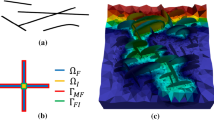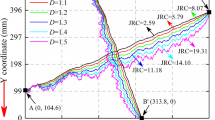Abstract
Film flow on fracture surfaces may be an important mechanism for fast flow in unsaturated fractured rocks. Incorporating this mechanism into a numerical model requires knowledge of constitutive relationships for film flow. Based on fractal concepts and a conceptual argument of Tokunaga et al. that water films could be treated as analogues to water in unsaturated porous media, a simple constitutive-relationship model has been developed. The validity of the model is supported by excellent agreements between calculation results and experimental observations for two different fracture surfaces.
Résumé
L’écoulement en film sur les surfaces de fracture peut être un mécanisme important pour l’écoulement rapide dans les roches fracturées non saturées. L’incorporation de ce mécanisme dans un modèle numérique nécessite la connaissance des relations fondamentales pour l’écoulement en film. Basé sur des concepts fractals et sur un argument conceptuel de Tokunaga et al. selon lequel des films d’eau peuvent être considérés comme des analogues de l’eau en milieu poreux non saturé, un modèle simple des relations fondamentales a été développé. La validité de ce modèle est confirmée grâce à une excellente concordance entre les résultats du calcul et les observations expérimentales pour deux surfaces différentes de fractures.
Resumen
El flujo pelicular en la superficie de las fracturas puede ser un mecanismo importante para el flujo rápido en rocas fracturadas no saturadas. Incorporarlo en un modelo numérico requiere conocer las relaciones constitutivas del flujo pelicular. Se ha desarrollado un modelo de una relación constitutiva sencilla partiendo de conceptos fractales y de un argumento conceptual de Tokunaga et al., según el cual las películas de agua pueden ser tratadas como análogos del agua en medios porosos no saturados. La validez del modelo es corroborada por los excelentes ajustes entre los resultados numéricos y las observaciones experimentales en dos superficies de fracturas diferentes.



Similar content being viewed by others
References
Bodvarsson GS, Tsang Y (guest eds) (1999) Yucca Mountain project. J Contaminant Hydrol 38:1–146
Brooks RH, Corey AT (1964) Hydraulic properties of porous media. Hydrology Pap 3. Colorado State University, Fort Collins
Brown SR, Scholz CH (1985) Broad bandwidth study of topography of natural rock surfaces. J Geophys Res 90(B14):12575–12582
Dragila MI, Wheatcraft SW (2001) Free-surface films. In: National Research Council (ed) Conceptual models of flow and transport in the fractured vadose zone. National Academy Press, Washington, DC
Ho CK (1997) Models of fracture-matrix interactions during multiphase heat and mass flow in unsaturated fractured porous media. In: Proc 6th Symp on Multiphase Transport in Porous Media, ASME International Mechanical Engineering Congr and Exposition, Dallas, Texas
Kravchenko A, Zhang R (1998) Estimating the soil water retention from particle-size distributions: a fractal approach. Soil Sci 163:171–179
Liu HH, Doughty C, Bodvarsson GS (1998) An active fracture model for unsaturated flow and transport in fractured rocks. Water Resour Res 34:2633–2646
National Research Council (1996) Rock fractures and fluid flow, contemporary understanding and applications. National Academy Press, Washington, DC
Or D, Tuller M (2000) Flow in unsaturated fractured porous media: hydraulic conductivity of rough surfaces. Water Resour Res 36:1165–1171
Perfect E, McLaughlin NB, Kay BD, Topp GC (1996) An improved fractal equation for the soil water retention curve. Water Resour Res 32:281–287
Power WL, Tullis TE, Brown SR, Boitnott GN, Scholz CH (1987) Roughness of natural fault surface. Geophys Res Lett 14:29–32
Pruess K (1999) A mechanistic model for water seepage through thick unsaturated zones in fractured rocks of low matrix permeability. Water Resour Res 35:1039–1051
Rieu M, Sposito G (1991a) Fractal fragmentation, soil porosity, and soil water properties, 1. Theory. Soil Sci Soc Am J 55:1231–1238
Rieu M, Sposito G (1991b) Fractal fragmentation, soil porosity, and soil water properties, 2. Applications. Soil Sci Soc Am J 55:1231–1238
Robinson BA, Wolfsberg AV, Viswanathan HS, Gable CW, Zyvoloski GA, Turin HJ (1996) Modeling of flow radionuclide migration and environmental isotope distribution at Yucca Mountain. Sandia National Laboratory Milestone 3672, Sandia National Laboratories, Texas
Schaap MG, Leij FJ (2000) Improved prediction of unsaturated hydraulic conductivity with the Mualem-van Genuchten model. Soil Sci Soc Am J 64:843–851
Thomas TR (1982) Rough surfaces. Longman, New York
Tokunaga TK, Wan J (1997) Water film flow along fracture surface of porous rock. Water Resour Res 33:1287–1295
Tokunaga TK, Wan J (2001) Approximate boundaries between different flow regimes in fractured rocks. Water Resour Res 37:2103–2111
Tokunaga TK, Wan J, Sutton SR (2000) Transient film flow on rough fracture surfaces. Water Resour Res 36:1737–1746
Tyler SW, Wheatcraft SW (1990) Fractal processes in soil water retention. Water Resour Res 26:1047–1054
Acknowledgments
We are indebted to Tetsu Tokunaga, Bo Bodvarsson and Guoping Lu at the Lawrence Berkeley National Laboratory for their critical and careful reviews of a preliminary version of this manuscript. We also appreciate the constructive comments from Managing Editor Perry Olcott, Dr. Fred J. Molz at Clemson University and an anonymous reviewer. This work was supported by the Director, Office of Civilian Radioactive Waste Management, US Department of Energy, through Memorandum Purchase Order EA9013MC5X between Bechtel SAIC Company, LLC, and the Ernest Orlando Lawrence Berkeley National Laboratory (Berkeley Lab). The support is provided to Berkeley Lab through the US Department of Energy Contract no. DE-AC03-76SF00098.
Author information
Authors and Affiliations
Corresponding author
Rights and permissions
About this article
Cite this article
Liu, H.H. A constitutive-relationship model for film flow on rough fracture surfaces. Hydrogeology Journal 12, 237–240 (2004). https://doi.org/10.1007/s10040-003-0297-x
Received:
Accepted:
Published:
Issue Date:
DOI: https://doi.org/10.1007/s10040-003-0297-x




